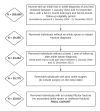Fractures and Chronic Recurrence are Commonly Associated with Ankle Sprains: a 5-year Population-level Cohort of Patients Seen in the U.S. Military Health System
- PMID: 34631252
- PMCID: PMC8486414
- DOI: 10.26603/001c.27912
Fractures and Chronic Recurrence are Commonly Associated with Ankle Sprains: a 5-year Population-level Cohort of Patients Seen in the U.S. Military Health System
Abstract
Background: Whereas ankle-foot injuries are ubiquitous and affect ~16% of military service-members, granularity of information pertaining to ankle sprain subgroups and associated variables is lacking. The purpose of this study was to characterize and contextualize the burden of ankle sprain injuries in the U.S. Military Health System.
Methods: This was a retrospective cohort study of beneficiaries seeking care for ankle sprains, utilizing data from the Military Health System Data Repository from 2009 to 2013. Diagnosis and procedural codes were used to identify and categorize ankle sprains as isolated lateral, isolated medial, concomitant medial/lateral, unspecified, or concomitant ankle sprain with a malleolar or fibular fracture. Patient characteristics, frequency of recurrence, operative cases, and injury-related healthcare costs were analyzed.
Results: Of 30,910 patients included, 68.4% were diagnosed with unspecified ankle sprains, 22.8% with concomitant fractures, (6.9%) with isolated lateral sprains, (1.7%) with isolated medial sprains and 0.3% with combined medial/lateral sprains. Pertaining to recurrence, 44.2% had at least one recurrence. Sprains with fractures were ~2-4 times more likely to have surgery within one year following injury (36.2% with fractures; 9.7% with unspecified sprains) and had the highest ankle-related downstream costs.
Conclusion: Fractures were a common comorbidity of ankle sprain (one in five injuries), and operative care occurred in 16.4% of cases. Recurrence in this cohort approximates the 40% previously reported in individuals with first-time ankle sprain who progress to chronic ankle instability. Future epidemiological studies should consider reporting on subcategories of ankle sprain injuries to provide a more granular assessment of the distribution of severity.
Level of evidence: 3b.
Keywords: ankle fracture; ankle sprain; epidemiology; injury severity; military medicine; tactical athlete.
Conflict of interest statement
No authors have any competing or conflicts of interest to declare
Figures
Similar articles
-
Epidemiology of Ankle Sprains and the Risk of Separation From Service in U.S. Army Soldiers.J Orthop Sports Phys Ther. 2015 Jun;45(6):477-84. doi: 10.2519/jospt.2015.5733. Epub 2015 Apr 21. J Orthop Sports Phys Ther. 2015. PMID: 25899214
-
Brain Neuroplasticity Related to Lateral Ankle Ligamentous Injuries: A Systematic Review.Sports Med. 2023 Jul;53(7):1423-1443. doi: 10.1007/s40279-023-01834-z. Epub 2023 May 8. Sports Med. 2023. PMID: 37155129
-
Delayed Rehabilitation Is Associated With Recurrence and Higher Medical Care Use After Ankle Sprain Injuries in the United States Military Health System.J Orthop Sports Phys Ther. 2021 Dec;51(12):619-627. doi: 10.2519/jospt.2021.10730. J Orthop Sports Phys Ther. 2021. PMID: 34847698
-
Persistent disability associated with ankle sprains: a prospective examination of an athletic population.Foot Ankle Int. 1998 Oct;19(10):653-60. doi: 10.1177/107110079801901002. Foot Ankle Int. 1998. PMID: 9801078
-
Epidemiology of Ankle Sprains and Chronic Ankle Instability.J Athl Train. 2019 Jun;54(6):603-610. doi: 10.4085/1062-6050-447-17. Epub 2019 May 28. J Athl Train. 2019. PMID: 31135209 Free PMC article. Review.
Cited by
-
Current concepts in the surgical management of chronic ankle lateral ligament instability.J Orthop. 2022 Jul 19;33:87-94. doi: 10.1016/j.jor.2022.07.006. eCollection 2022 Sep-Oct. J Orthop. 2022. PMID: 35874042 Free PMC article. Review.
-
Examination of Ankle Trauma in United States Military Members: A Scoping Review.Cureus. 2022 Dec 4;14(12):e32175. doi: 10.7759/cureus.32175. eCollection 2022 Dec. Cureus. 2022. PMID: 36605064 Free PMC article.
-
Revealing the Progression of Pain Pathways and Identifying Chronification of Pain Predictors After an Isolated Lateral Ankle Sprain: Project RECOIL.J Pain Res. 2025 Feb 26;18:931-945. doi: 10.2147/JPR.S488420. eCollection 2025. J Pain Res. 2025. PMID: 40027208 Free PMC article.
-
Validity and Responsiveness of a Modified Balance Error Scoring System Assessment Using a Mobile Device Application in Patients Recovering from Ankle Sprain.Int J Sports Phys Ther. 2024 Apr 1;19(4):440-450. doi: 10.26603/001c.94608. eCollection 2024. Int J Sports Phys Ther. 2024. PMID: 38576835 Free PMC article.
-
Uneven Treadmill Training for Rehabilitation of Lateral Ankle Sprains and Chronic Ankle Instability: Protocol for a Pragmatic Randomized Controlled Trial.JMIR Res Protoc. 2022 Jun 22;11(6):e38442. doi: 10.2196/38442. JMIR Res Protoc. 2022. PMID: 35731551 Free PMC article.
References
-
- Comparing the population health impacts of medical conditions using routinely collected health care utilization data: Nature and sources of variability. Brundage John F., Johnson Karen E., Lange Jeffrey L., Rubertone Mark V. Oct;2006 Military Medicine. 171(10):937–942. doi: 10.7205/milmed.171.10.937. doi: 10.7205/milmed.171.10.937. - DOI - DOI - PubMed
-
- Incidence of ankle sprains among active-duty members of the United States armed services from 1998 through 2006. Cameron Kenneth L., Owens Brett D., DeBerardino Thomas M. Jan 1;2010 Journal of Athletic Training. 45(1):29–38. doi: 10.4085/1062-6050-45.1.29. doi: 10.4085/1062-6050-45.1.29. - DOI - DOI - PMC - PubMed
-
- Sex and occupation are salient factors associated with lateral ankle sprain risk in military tactical athletes. Fraser John J., MacGregor Andrew J., Ryans Camille P., Dreyer Mark A., Gibboney Michael D., Rhon Daniel I. Jul;2021 Journal of Science and Medicine in Sport. 24(7):677–682. doi: 10.1016/j.jsams.2021.02.016. doi: 10.1016/j.jsams.2021.02.016. - DOI - DOI - PubMed
LinkOut - more resources
Full Text Sources
Medical
Research Materials


